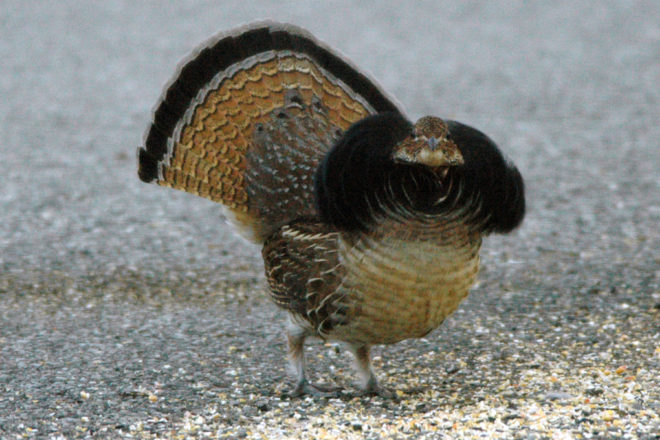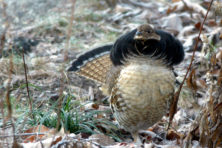Door to Nature: Ruffed Grouse
- Share
- Tweet
- Pin
- Share

I was driving home from Egg Harbor when I noticed a hen ruffed grouse begin to cross Church Street about 30 feet ahead of me. I stopped to let her go, and after a bit of hesitation, she quickly and carefully crossed within the crosswalk lines, with her 12 newly hatched chicks close behind.

A mother grouse and 12 chicks walk across an Egg Harbor street. Photo by Charlotte Lukes.
This was a treat to see, and I was able to snap a few photos. By the time the grouse family had crossed, cars were waiting behind me, so I drove on and did not see where it went.
Ruffed grouse are rather secretive and nest in wooded areas, so it was a bit surprising to see them right in the village. Their gorgeous, mottled plumage blends in with their natural surroundings of dried leaves, other debris and plants on the ground, making them difficult to see.
I remember my first hike with my late husband, Roy, in a wooded area where grouse were common. We were near an adult grouse that saw us before we saw it. Grouse are known to burst into flight – which it did – in such a rapid, noisy, startling way that they’re out of sight before you regain your composure.
Someone called us long ago to tell about an experience with a “ruffled” grouse. Roy smiled a bit and asked whether the caller meant a ruffled spouse! The grouse is often called a partridge. It’s in the Phasianidae family, which includes pheasants, partridges, ptarmigans and wild turkeys.
Ruffed grouse prefer habitats of small-toothed aspen, oak woods and mixed conifers, and they reside in such environments from the Appalachian Mountains up into New England, and throughout much of Michigan and the northern half of Wisconsin and Minnesota. They are also found in western Wyoming, Montana, northern Idaho and throughout Canada.
Populations tend to go through an eight-to-11-year cycle, in accordance with the lives of the snowshoe hare. When the hares are abundant, their predator numbers increase; when the hares become scarce, the predators concentrate on grouse instead, and the grouse numbers decline.
During the early years of living in our inland hardwood forest, we had a good ruffed grouse population and enjoyed watching the birds high in the small-toothed aspen trees during the winter, nibbling on the buds and silhouetted against a colorful, fading sunset sky.
Nesting occurs in deciduous and deciduous-conifer forests with dense understory plants and aspen groves nearby. The female does all the nest building and often sets the nest at the base of a tree, under branches of a fallen tree or near a log. A clutch averages nine to 12 eggs, which are incubated for about 24 days.
The chicks are precotial, meaning that they’re up and running as soon as they hatch. The hen aggressively defends her young, and they stay with her until early autumn. Once they’re as large as the adults, the parents send them away to occupy new territories.
We’ve had numerous friends tell of a single grouse approaching them during the fall, seeming completely unafraid of people and staying in the yard for prolonged periods. These are usually youngsters that have been shunted off by the parents and are confused about where to go.
April and May are the most common times to hear the drumming of a ruffed grouse. A male finds a fallen log to stand on and begins to flap his wings slowly. The sound is similar to an engine starting up, but then the flapping speed gradually increases to an absolute whirring sound as the grouse finishes his display – usually to attract a mate and stake out territory.
Another part of the courtship ritual takes place when the male grouse fans his tail to its widest and expands the black “ruff” of feathers around his neck to make himself more attractive to the hen that’s often up in a nearby tree.
Roy photographed a male grouse on our driveway doing this fantastic display. The hen sat nonchalantly on a branch and didn’t seem interested, but we were certainly impressed!

